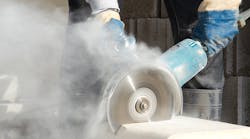U.S. Court of Appeals Rejects 'All of Industry's Challenges' to Silica Rule
OSHA’s silica rule has weathered its court challenge and remains in effect, with a three-judge panel for the U.S. Court of Appeals for the District of Columbia on Dec. 22 rejecting all five objections raised by industry groups.
A spokesperson for the U.S. Chamber said the chamber still is reviewing the decision, "but we continue to believe that OSHA lacks substantial evidence to support its rule."
In the United States, more than 2 million workers currently are exposed to some level of silica. In 2016, OSHA published a final rule regulating workplace exposure to silica, Occupational Exposure to Respirable Crystalline Silica (29 CFR 1910, 1915 and 1926).
The court, in its decision, noted that petitions to review the silica rule came from both industry and unions. “A collection of industry petitioners believes OSHA impermissibly made the rule too stringent and several union petitioners believe OSHA improperly failed to make the rule stringent enough.”
The industry groups petitioned for review of five issues:
- Whether substantial evidence supports OSHA’s finding that limiting workers’ silica exposure to the level set by the rule reduces a significant risk of material health impairment.
- Whether substantial evidence supports OSHA’s finding that the rule is technologically feasible for the foundry, hydraulic fracturing and construction industries.
- Whether substantial evidence supports OSHA’s finding that the rule is economically feasible for the foundry, hydraulic fracturing and construction industries.
- Whether OSHA violated the Administrative Procedure Act (APA) in promulgating the rule.
- Whether substantial evidence supports two ancillary provisions of the rule; one that allows workers who undergo medical examinations to keep the results confidential from their employers and one that prohibits employers from using dry cleaning methods unless doing so is infeasible.
“We reject all of industry’s challenges,” wrote judges Merrick Garland, Karen Henderson and David Tatel.
”The labor movement worked for decades to win these lifesaving measures, and we are proud to see these standards remain the law of the land,” said AFL-CIO President Richard Trumka. “I want to thank all of those who contributed to this great victory, including the Obama administration and the career staff at the Department of Labor. Now we must turn our efforts to making sure this standard is put into full effect, enforced and protected from further attacks so that workers are finally protected from deadly silica dust.”
The unions requested review of two parts of the rule:
- The requirement that medical surveillance for construction workers be provided only if the employee has to wear a respirator for 30 days for one employer in a one-year period.
- The absence of medical removal protections.
“We reject the unions’ challenge to the construction standard’s 30-day trigger for medical surveillance,” wrote the judges. They added, however: “We hold that OSHA was arbitrary and capricious in declining to require MRP for some period when a medical professional recommends permanent removal, when a medical professional recommends temporary removal to alleviate COPD symptoms, and when a medical professional recommends temporary removal pending a specialist’s determination.”
The judges concluded that OSHA “failed to adequately explain its decision to omit medical removal protections from the rule and remand [back to OSHA] for further consideration of the issue.”
“This is a huge win for millions of workers in construction, foundries, mining, shipbuilding and many other industries,” stated Jessica Martinez, co-executive director of the, National Council for Occupational Safety and Health. “Low-wage workers and those in the informal sector can now be assured of safer working conditions.”

